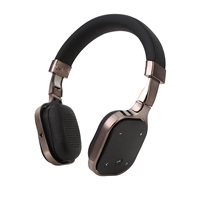
In-ear monitors extend into the ear canal, providing isolation from outside noise. A headset is a headphone combined with a microphone. Telephone headsets connect to a fixed-line telephone system. A telephone headset functions by replacing the handset of a telephone....
Earphones (popularly called "earbuds" in recent years) are very small headphones that are fitted directly in the outer ear, facing but not inserted in the ear canal. Earphones are portable and convenient, but many people consider them to be uncomfortable. They provide hardly any acoustic isolation and leave room for ambient noise to seep in; users may turn up the volume dangerously high to compensate, at the risk of causing hearing loss. On the other hand, they let the user be better aware of their surroundings. Since the early days of the transistor radio, earphones have commonly been bundled with personal music devices. They are sold at times with foam pads for comfort.
In-ear headphones
In-ear monitors extend into the ear canal, providing isolation from outside noise.
In-ear headphones, also known as in-ear monitors (IEMs) or canalphones, are small headphones with similar portability to earbuds that are inserted in the ear canal itself. IEMs are higher-quality in-ear headphones and are used by audio engineers and musicians as well as audiophiles.
Because in-ear headphones engage the ear canal, they can be prone to sliding out, and they block out much environmental noise. Lack of sound from the environment can be a problem when sound is a necessary cue for safety or other reasons, as when walking, driving, or riding near or in vehicular traffic.
Generic or custom-fitting ear canal plugs are made from silicone rubber, elastomer, or foam. Custom in-ear headphones use castings of the ear canal to create custom-molded plugs that provide added comfort and noise isolation.
Headset
A typical example of a headset used for voice chats.
A headset is a headphone combined with a microphone. Headsets provide the equivalent functionality of a telephone handset with hands-free operation. Among applications for headsets, besides telephone use, are aviation, theatre or television studio intercom systems, and console or PC gaming. Headsets are made with either a single-earpiece (mono) or a double-earpiece (mono to both ears or stereo). The microphone arm of headsets is either an external microphone type where the microphone is held in front of the user's mouth, or a voicetube type where the microphone is housed in the earpiece and speech reaches it by means of a hollow tube.
Telephone headsets
Telephone headsets connect to a fixed-line telephone system. A telephone headset functions by replacing the handset of a telephone. Headsets for standard corded telephones are fitted with a standard 4P4C commonly called an RJ-9 connector. Headsets are also available with 2.5 mm jack sockets for many DECT phones and other applications. Cordless bluetooth headsets are available, and often used with mobile telephones. Headsets are widely used for telephone-intensive jobs, in particular by call centre workers. They are also used by anyone wishing to hold telephone conversations with both hands free.
For older models of telephones, the headset microphone impedance is different from that of the original handset, requiring a telephone amplifier for the telephone headset. A telephone amplifier provides basic pin-alignment similar to a telephone headset adaptor, but it also offers sound amplification for the microphone as well as the loudspeakers. Most models of telephone amplifiers offer volume control for loudspeaker as well as microphone, mute function and switching between headset and handset. Telephone amplifiers are powered by batteries or AC adaptors.
Customer Service
